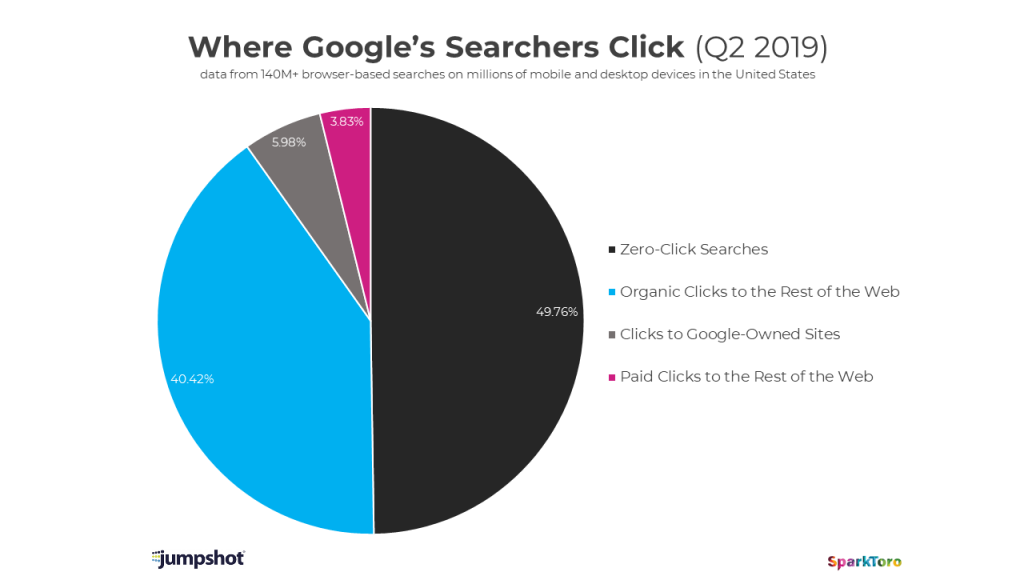We’ve passed a milestone in Google’s evolution from search engine to walled-garden. In June of 2019, for the first time, a majority of all browser-based searches on Google.com resulted in zero-clicks.
Throughout this post, I’ll be using numbers from the clickstream data company, Jumpshot. They are, in my opinion, the best, most reliable source of information on what happens inside web browsers because of how they gather, process, and scale their estimates. That’s why SparkToro, and Moz (my previous company) are both customers of Jumpshot. Given all the nice things I say about them, it might sound like they’re paying me, but the opposite is true; we’re paying them. You can find more on their methodology in the endnote on this post.
Let’s go back, for a moment, to July 23rd, 2019. After a United States Congressional panel asked Adam Cohen, Google’s representative, direct questions about Google’s activities (video link) and found his responses… lacking… the Chairman of the committee, David Cicilline (of Rhode Island), sent this extraordinarily clear request (full PDF here):

I love the clarity of this format. The Congressman makes it known that while Google is welcome to attach more information, they must check a yes/no box. Let’s see how Google responds…

Sigh… Maybe I need to stop being disappointed in Google and just start expecting them to lie, mislead, and refuse direct questions. I know a lot of wonderful people who work at Google, and I know at least a handful of them who are less than thrilled by how their peers represented the company here.
But, since Google won’t give clear answers, I’ll let Jumpshot’s data do it for them. Below is a visual showing where searches happened on mobile and desktop browsers in April, May, and June of 2019 (Q2):
June (as shown at the top of this post) is when zero-click searches in browsers passed 50%, but the pie chart above shows that even before that, Google was sending a huge portion of search clicks to their own properties (~6% of queries and ~12% of clicks). Those properties include YouTube, Maps, Android, Google’s blog, subdomains of Google.com, and a dozen or so others (full list here).
Maybe Google’s websites are ranking exclusively because they’re the best result, but if Congress is asking questions about whether a monopoly is potentially abusing its market dominance in one field to unfairly compete in another, I’ve got something else they’ll want to see. It’s a chart of where searches happened on major web properties in Q2, and as you can see, there’s no competition.
Google is almost certainly even more dominant than the chart above suggests. That’s because mobile apps, which Jumpshot doesn’t currently measure, aren’t included — this is just browser-based search data. The Google Maps App, Google Search App, and YouTube are installed on almost every mobile device in the US, and likely have so much usage that, if their search statistics were included, Google’s true market share would be 97%+.
That makes them a clear monopoly in search. And a lot of folks think it’s somewhere between odd and suspicious how well Google’s features and properties have done over time.
Google is such a great company, they’ve never been hurt by a major algorithm update 📈
— Cyrus (@CyrusShepard) August 9, 2019
Maps, YouTube, Fights, Shopping, and more win almost every time. (And the Ads department is on 🔥)
A testiment to their great content, really.
Next, let’s look at how these clickthrough rates have changed over time.
We can see a consistent pattern: organic shrinks while zero-click searches and paid CTR rise. But the devil’s in the details and, in this case, mostly the mobile details, where Google’s gotten more aggressive with how ads and instant answer-type features appear.
Above is the distribution of search clicks across the millions of mobile devices in Jumpshot’s panel. Below is that same distribution for millions of desktop devices.
On desktop, things haven’t changed all that much in the last three years. Organic is down a few percent, paid and zero-click are up a bit, but June of 2019 isn’t far off January of 2016.
On mobile, where more than half of all searches take place, it’s a different story. Organic has fallen by almost 20%, while paid has nearly tripled and zero-click searches are up significantly. Even way back in January 2016, more than half of mobile searches ended without a click. Today’s, it’s almost 2/3rds.
Three trends are made clear by these numbers:
- The percent of searches available as organic traffic from Google is steadily declining, especially on mobile.
- Paid clicks tend to increase whenever Google makes changes to how those results are displayed, then slowly decline as searchers get more familiar with spotting and avoiding them.
- Google’s ongoing attempts to answer more searches without a click to any results OR a click to Google’s own properties are both proving successful. As a result, zero-click searches, and clicks that bring searchers to a Google-owned site keep rising.
What’s a smart marketer, entrepreneur, or web creator to do?
- Find ways to get value from zero-click searches
- Seek out keywords whose results have higher CTR opportunity
- Get your content optimized on Google’s own properties (YouTube, Maps, Images, AMP, Knowledge Panels, etc.)
- Hope that the recently opened investigations into Google’s anti-competitive behavior yield results (either findings that this behavior isn’t anti-competitive, or consequences that return market opportunity)
Methodology Notes:
Jumpshot is the data arm of Avast, a well-regarded maker of numerous Internet security products. This suite of products, in order to function, must collect and analyze every URL visited by every browser of every machine on which its installed. That includes millions of Android-powered devices and millions of PCs as well. They have much lower coverage on iOS devices and so don’t report on visit data from those browsers.
Because Avast has to see and process all these URLs anyway (in order to serve their function of providing web security), they anonymize, aggregate, and remove any personally-identifiable information from the browser URL visits and then provide them to Jumpshot, who then makes estimates about broad web usage behavior. In my opinion, this is both an ethical way to gather crucial data about what’s happening on the web, and a great way for data analysts like me to get web-scale, high-accuracy numbers.
Jumpshot’s panel worldwide is over 100 million devices. In the United States alone, it’s in the many millions (though Jumpshot keeps the precise size private). By my estimates (Rand’s best guess, not Jumpshot’s) it’s somewhere between 2-6% of the total number of mobile and desktop Internet-browsing devices in the US, AKA a statistically significant sample size. Undoubtedly, this device panel has biases — perhaps iOS users (which aren’t counted) search more often on average, or click on results more often when they do search. Maybe Jumpshot’s panel of users is slightly more likely to use Google or less likely to use Bing than the average web user.
But, overall, it’s likely these biases are small (a few percentage points at most). And so far, I haven’t seen evidence of any bias that suggests the way Jumpshot’s users search and click is different from the way any other group of web browsers is. If that ever changes, I’ll make sure to update this piece.
UPDATE: Several folks have asked for more clarification and detail on what is meant by a “Zero-click” search.
- The most literal definition is a search that results in zero website referrals, i.e. no web property receives a visit from the search.
- Searches that are answered by the results, searches that end because a user was frustrated and couldn’t find an answer, searches that end because something interrupted the searcher, or any other reason for a cessation of activity after the query would all count as “zero click” searches.
- Because Jumpshot only measures browser behavior, a click/action that takes a searcher out of the browser (for example, opening the phone app for a click-to-call, or the Google Maps app for driving directions) will be categorized under zero-click searches.
- Voice searches that show a screen of results are part of this analysis. Searches that are answered by a device’s audio (like Alexa, Siri, Google Assistant, etc. speaking an answer) are not counted.
Have more questions about Jumpshot? Feel free to reach out to them directly here.





